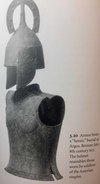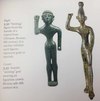Neer Chapters 3-4 Flashcards
(76 cards)
A

Phoenician temple at Komnos, Crete (c. 925–600 BCE). Three pillar-figures inside.
A

Syrian-Cretan jewelry from the tomb at Tekke near Knossos. Gold; late 9th century BCE. Extensive use of granulation (tiny gold balls) and filigree (fine gold wire)
A

Drawing of a Syrian-Cretan shield from the Cave of Zeus (Mount Ida) on Crete. Bronze; 8th century BCE. Known as “the Hunt Shield,” it depicts warriors fighting wild beasts in concentric rings; the central feline head is embossed.
A

Syrian-Cretan lyre-player, from Crete. Bronze; 8th century BCE.
A

Reconstruction drawing of the apsidal hall at Lefkandi, Euboia. 10th century BCE. Dashed lines indicate the burial site of the “hero” and his consort.
A

Phoenician bowl from the Toumba cemetery (Grave 55), decorated with concentric rings featuring panthers and sphinxes. Bronze; c. 10th century BCE.
A

Attic Submycenaean stirrup jar from the Kerameikos cemetery, Athens. Ceramic, c. 11th century BCE.
A

Attic Protogeometric neck-handled amphora. Ceramic; c. 1050-950 BCE. Compare the semicircles on the shoulder to those in 3.7
A

Attic Early Geometric neck-handled amphora. Ceramic; c. 900-850 BCE.
A

Attic Middle Geometric belly-handled amphora from Eleusis. Ceramic, c. 860-760 BCE
A

Attic Late Geometric I belly-handled amphora. Ceramic; c. 760-735 BCE. Main panel, level with the handles, shows mourners with the body of a woman.
A

Attic Late Geometric I krater: funeral processions. Ceramic; c. 760-735 BCE.
A

Attic Late Geometric I krater (detail): fight at a ship. Ceramic, c. 750-735 BCE.
A

Attic Late Geometric II neck-handled amphora: mourners, warriors and horses. Ceramic; c. 735-690 BCE.
A

Euboian Late Geometric krater from Cyprus (the Cesnola krater). Ceramic; mid-8th century BCE. At center, goats nibble a Tree of Life and to either side are horses with double axes (Bronze Age holdovers?).
A

Euboian Sub-Protogeometric skyphos (cup) decorated with pendant semicircles. Ceramic; 10th-8th century BCE. This type of cup is found around the Mediterranean and plays an important role in the archaeology of the period.
A

Ionian “bird bowl.” Ceramic; c. 625 BCE. Important pottery type, widely distributed in the East Greek world.
A

Development of Athenian cremation burials over time. Drawing shows how changes in pottery style correspond roughly to changes in burial practices.
A

Reconstruction drawing of Smyrna (modern Izmir, on the west coast of Turkey) in the 8th century BCE. Note the city wall.
A

Armor from a “heroic” burial at Argos. Bronze; late 8th century BCE. Helmet resembles those worn by soldiers of the Assyrian Empire.
A

Bronze urn for holding cremated remains, with marble lid and stone receptacle. From the West Gate cemetery at Eretria; c. 720 BCE.
A

Phases of the West Gate cemetery at Eretria, showing how a private grave evolved into a family cemetery and, eventually, a monumental shrine.
A

Plan of a probably ruler’s dwelling at Nichoria in the Peloponnesos (phase IV.I); c. 975-800 BCE. Note the paved circle towards the rear: used for cult activity, it suggests a close association between the ruler and religion. Compare 2.2 (Early Helladic), 5.10 (Middle Helladic), and 3.5 (Protogeometric).
A

Phases of the Temple of Apollo Daphnephoros (the Laurel-Bearer) at Eretria, showing its evolution from an apsidal hall into a rectilinear temple with a surrounding colonnade.






















































